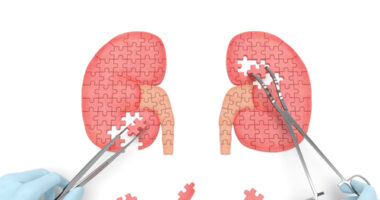Review Highlights Knowledge of Alport Disease Cellular, Molecular, Mechanical Drivers

Changes in cellular and molecular signaling, as well as increased mechanical strain, likely contribute to the development and progression of kidney damage in Alport disease.
An overview, “Collagen IV diseases: A focus on the glomerular basement membrane in Alport syndrome,” published in the journal Matrix Biology, explored what scientists know about the cellular and molecular forces causing the kidneys to stop working in Alport patients.
The review was authored by two researchers from Boys Town National Research Hospital in Nebraska and Sanofi-Genzyme.
Mutations in one of the three type IV collagen genes COL4A3, COL4A4, or COL4A5 dramatically change the anatomy of the glomerular basement membrane — the part of the kidney where urine is filtered from the blood.
As the three collagens form a structure composed of one molecule each, a mutation in any of the genes make it impossible to form the complex, and so, an entire collagen network composed of the three collagen types is missing in Alport disease.
Nevertheless, it is not the lack of the collagen network that directly causes the kidney to become leaky, as people with the condition live years before proteins start to enter the urine. Work in both animal models of Alport and patients also show that early on, the basement membrane is thinner than normal, but is not yet torn.
Studies have shown that a lack of the collagen network composed of the A3, A4, and A5 proteins changes the cellular signaling in kidney cells. In particular, two receptors for collagen seem to be driving disease progression, as mice lacking any of the two live longer and fare better.
Other studies point to the fact that the thinner basement membrane causes kidney cells to be exposed to an increased mechanical strain, which also contributes to the gradual destruction of the kidney in Alport patients.
Genetically engineered Alport mice are sensitive to high blood pressure, and experiments with drugs that lower the blood pressure by acting on a kidney molecular signaling cascade known as RAAS show that such drugs slow disease progression in mice.
Since such drugs lower the blood pressure, and therefore reduce the mechanical forces in the kidney, some researchers view the experiments as proof that such mechanics are driving the disease. Yet others point out that molecular signaling through the RAAS pathway itself is changed in Alport.
Of the three cell types present in the glomerulus, scientists suggest that the so-called mesangial cells seem to be particularly affected, in turn giving rise to changes in cellular signaling events, including inflammatory processes.
Studies targeting identified molecules have reached various degrees of success, but since a mutation causes the lack of an entire collagen network, the authors argue that gene therapy would be the obvious primary approach. Alternatively, stem cell therapy to replace damaged cells may be another approach.
However, these therapies are nowhere near clinical applications, and in the meantime, chemical chaperones — factors that aid a mutant protein to fold properly — should be considered for the 40 to 50 percent of patients affected by such mutations.
Also, a treatment currently in clinical trials uses a compound blocking the microRNA miR-21, which seems to be beneficial by reducing inflammatory and oxidative processes. Nevertheless, the authors maintain that all new therapies should be tested in combination with drugs affecting the kidney RAAS system, such as the ACE blocker Altace (ramipril).







Leave a comment
Fill in the required fields to post. Your email address will not be published.